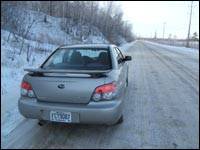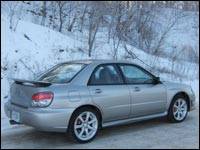Technical
What else will you find under the hood of a Subaru but the famous 2.5L horizontally opposed flat 4 cylinder engine. To be truthful, only Subaru's midsize SUV, the B9 Tribeca, makes due without. There are three models of the Impreza sedan and therefore, three very differe
nt outputs. The first is normally-aspirated and delivers 173 hp and 166 lb/ft of torque. My tested WRX engine power, boosted literally by a turbocharger, installs grins on the driver's face with 230 hp and 235 lb/ft of torque. Last and certainly not least, the WRX STi tears up unsuspecting neighbourhoods with 300 hp and 300 lb/ft of torque. Transmission choices are between a 5-speed manual and a 4-speed automatic for the 2.5i and the WRX. The STi receives a 6-speed manual. All of Subaru's vehicles feature their Symmetrical AWD system which is on a constant vigil of road conditions.
All Imprezas are shod with 4-wheel disc brakes and a fully independent suspension.
On the road
The words turbo and AWD go together like a horse and carriage or a Big Mac and fries. The best way to exploit power is by making sure that it can properly be channelled to the road. Subaru's symmetrical AWD system is a sure-fire way of getting those 230 hp to the 17" tires. There is some lag at lower engine speeds but by shifting at the right RPM, it is possible to bypass this small annoyance. Speaking of changing gears, the clutch pedal is very heavy and the shifter's travel is notchy. In traffic situations is when the weight is really felt especially on the calf muscles. This is the price to pay to have high-performance heavy-duty internals. I would pay over and over again.
channelled to the road. Subaru's symmetrical AWD system is a sure-fire way of getting those 230 hp to the 17" tires. There is some lag at lower engine speeds but by shifting at the right RPM, it is possible to bypass this small annoyance. Speaking of changing gears, the clutch pedal is very heavy and the shifter's travel is notchy. In traffic situations is when the weight is really felt especially on the calf muscles. This is the price to pay to have high-performance heavy-duty internals. I would pay over and over again.
The extra 3 hp from the jump to a 2.5L from a 2.0L is not noticeable. What is though is a significantly quieter engine. The 2.0L growled and barked much louder and I miss it. Power is still impressive. My estimates for the not-to-sixty run are in the 5.7 to 5.8 second range. Very quick indeed. Fuel consumption, given the heavy right foot syndrome, was still fairly reasonable at 13.0 L per 100 km.
I had the incredible opportunity to drive the car in a snowstorm that dumped 41 cm of snow on the greater Montreal area. Now, I have always been a big fan of Subaru and AWD vehicles but this experience has solidified the fact that my next car will without a doubt be equipped with some form of AWD. My WRX was also shod with Bridgestone Blizzak winter tires. Let us just say that I had a little too much fun that day.
equipped with some form of AWD. My WRX was also shod with Bridgestone Blizzak winter tires. Let us just say that I had a little too much fun that day.
Given the nature of this car, my next favourite thing about the WRX, after the turbo and the AWD, is the fact that it is without all the electronic wizardry (stability and traction control) save for ABS brakes. This means that the driver is solely responsible, with the help of the added traction, for where the WRX is headed. In my eyes, it is a positive aspect for this particular vehicle, in a time where some cars have these systems which cannot be deactivated.
Steering is precise and assistance is spot on. This is principally true when carrying a fishtail manoeuvre and trying to bring it back. The brakes are mostly adequate. Stopping power is fine; however the brake pedal is disastrous. The feel is wooden and disconnected and pedal modulation is tedious. The discs and pads do resist well to repeated high-speed use but the level of concentration required to stop is disconcerting.
What else will you find under the hood of a Subaru but the famous 2.5L horizontally opposed flat 4 cylinder engine. To be truthful, only Subaru's midsize SUV, the B9 Tribeca, makes due without. There are three models of the Impreza sedan and therefore, three very differe
 |
All Imprezas are shod with 4-wheel disc brakes and a fully independent suspension.
On the road
The words turbo and AWD go together like a horse and carriage or a Big Mac and fries. The best way to exploit power is by making sure that it can properly be
 channelled to the road. Subaru's symmetrical AWD system is a sure-fire way of getting those 230 hp to the 17" tires. There is some lag at lower engine speeds but by shifting at the right RPM, it is possible to bypass this small annoyance. Speaking of changing gears, the clutch pedal is very heavy and the shifter's travel is notchy. In traffic situations is when the weight is really felt especially on the calf muscles. This is the price to pay to have high-performance heavy-duty internals. I would pay over and over again.
channelled to the road. Subaru's symmetrical AWD system is a sure-fire way of getting those 230 hp to the 17" tires. There is some lag at lower engine speeds but by shifting at the right RPM, it is possible to bypass this small annoyance. Speaking of changing gears, the clutch pedal is very heavy and the shifter's travel is notchy. In traffic situations is when the weight is really felt especially on the calf muscles. This is the price to pay to have high-performance heavy-duty internals. I would pay over and over again. The extra 3 hp from the jump to a 2.5L from a 2.0L is not noticeable. What is though is a significantly quieter engine. The 2.0L growled and barked much louder and I miss it. Power is still impressive. My estimates for the not-to-sixty run are in the 5.7 to 5.8 second range. Very quick indeed. Fuel consumption, given the heavy right foot syndrome, was still fairly reasonable at 13.0 L per 100 km.
I had the incredible opportunity to drive the car in a snowstorm that dumped 41 cm of snow on the greater Montreal area. Now, I have always been a big fan of Subaru and AWD vehicles but this experience has solidified the fact that my next car will without a doubt be
 equipped with some form of AWD. My WRX was also shod with Bridgestone Blizzak winter tires. Let us just say that I had a little too much fun that day.
equipped with some form of AWD. My WRX was also shod with Bridgestone Blizzak winter tires. Let us just say that I had a little too much fun that day.Given the nature of this car, my next favourite thing about the WRX, after the turbo and the AWD, is the fact that it is without all the electronic wizardry (stability and traction control) save for ABS brakes. This means that the driver is solely responsible, with the help of the added traction, for where the WRX is headed. In my eyes, it is a positive aspect for this particular vehicle, in a time where some cars have these systems which cannot be deactivated.
Steering is precise and assistance is spot on. This is principally true when carrying a fishtail manoeuvre and trying to bring it back. The brakes are mostly adequate. Stopping power is fine; however the brake pedal is disastrous. The feel is wooden and disconnected and pedal modulation is tedious. The discs and pads do resist well to repeated high-speed use but the level of concentration required to stop is disconcerting.





